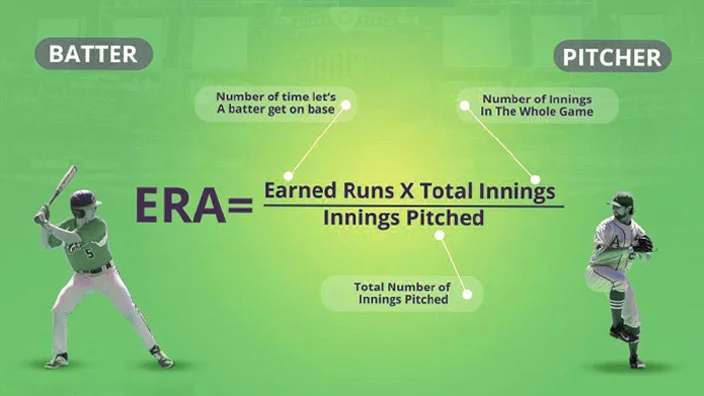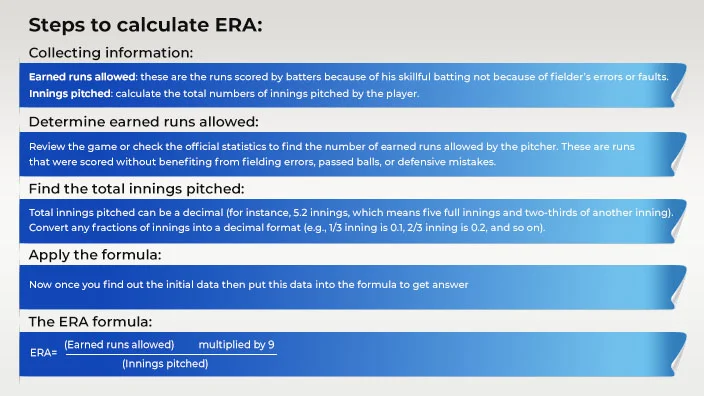Earned runs average (ERA) is one of the statistics used in baseball to calculate how effective the pitcher is in the game. It is the most widely used statistics in the baseball game; therefore it is frequently asked how to calculate era.
In simple words, Earned Runs Average (ERA) does not take into account the total number of runs where the pitcher is not responsible. ERA is a best tool for coaches and selectors to evaluate how good the pitcher is.
In this article, we will be speaking about the Era, defining it in more obvious terms, rules to calculate era, pros and cons of the calculating era, the applicable formulas followed by some important tips to know.
Table of Contents
The Significance
It is used to evaluate the performance of the pitcher not just in a single game but his whole career. ERA is a sort of informant that record stat of any pitcher gave.
You can imagine it as statistics on the basis of which a pitcher can stay in the major league baseball if the pitcher is having a great ERA. If a pitcher does not perform well in a baseball game but overall has a solid ERA, he can stay in the national league games.
Suggested Reading: How to Match Wall Color with Wood Floor
ERA is mostly used in baseball game innings. It is like calculating an average number of a batsman in cricket game. A player with having good batting or bowling average can be selected for the major league baseball.
Just like that, a pitcher can stay in the tournament if he has a solid ERA. But keep in mind that cricket game is very different from baseball game therefore calculating ERA is different than calculating average number in cricket game innings.

In the baseball game, to determine the worth of a pitcher to determine how many runs he allows. This is the root of calculating ERA. ERA is a stat that breaks down how many earned runs a pitcher allows for every 9 innings.
It accounts for runs where the pitcher is responsible therefore; it is named as “earned run average”. To put differently, a pitcher is not penalized or punished for runs caused by reasons other than his pitching. Just like fielding error or runs scored by base-runners who got on base with a different pitcher on the mound.
Understand ERA
Earned runs average is the number of earned runs by opposing team due to the fault of the pitcher. It does not count errors which is not basically the fault of the pitcher.

It only counts the runs that the pitcher is responsible for. Here is a simple guide on how you can understand about ERA:-
Understanding Rules to Calculate Era
To calculate ERA, first of all you need to determine when the pitcher was pulled from the game. All three of those individuals would be counted against a pitcher's ERA, for instance, if he pitched three innings then allowed a man on every base in the fourth inning before being pulled.
Just because he was the pitcher when they crossed home plate does not mean that they move on to the next one.
Don't count unearned runs
It is important to note down that earned runs are caused by hits for which the pitcher is solely responsible, whereas unearned runs are usually caused by errors or faults for which the pitcher is not responsible. Therefore, unearned runs do not count against the pitcher`s ERA.
Take this simple example to understand the unearned and earned runs. Let`s say we have runners on 2nd and 3rd base, with 2 outs.
When the pitcher strikes the ball to the batter, it ends up a routine ground ball to the first basemen, but the first basemen fumble it and can`t make a play to get an out. One runner scores and two are still left on base.
The run is unearned. Therefore it is necessary to count earned runs against the pitcher for which he is solely responsible.
Required fields
In order to compute ERA correctly, you will need three parts: the earned runs, the innings pitched, and the total number of innings.
- Earned runs are the number of times a pitcher lets a batter get on base. This should be entire number for the whole game.
- The innings pitched is like the total number of innings that the pitcher has pitched. The number will always end in thirds. This is so for every inning three strikes can be made by the fielding team. Which leaves you with three possible outcomes: the whole inning (three outs), an inning with two outs (ends in .66), or an inning with one out (ends in .33).
- The total number of innings in the game refers to the number of innings in a complete game (9).
The number of times a pitcher allows a batter to reach base is termed as earned runs. The complete number of innings the pitcher has pitched is indicated by the term “innings pitched”.
This number has always third at the end every time the pitcher pitched. This is because that the fielding team can record three strikes for each partial inning or full inning.
Pros and Cons of ERA
Till now you have learned that ERA is a good statistic to evaluate the performance of the pitcher. Through the data obtained from ERA, it is easy to judge a pitcher`s performance. But ERA should also be used with other statistics to help in indicating how well a pitcher has performed.

As you might consider that ERA is a good statistic but many people believe that this statistic is flawed. In this section, we will give your insight on the good and bad side of ERA to enable you to think whether ERA is good statistic or bad statistic.
Pros: -
Some of the key pros of determining and evaluating the ERA have been discussed below for the quick reference.
- ERA is widely accepted stat
- Easy to understand
- ERA filters out defensive mistakes
Cons: -
Apart from the pros discussed above concerning the evaluation method of era; lets discuss in some detail the cons of using the formula and principles' of ERA: -
- Other statistics are more accurate as below
RA9: It is simply the number of runs allowed per nine innings in a nine inning game regardless of whether those runs were earned runs or unearned runs.
FIP: it is the number that takes into account the plays the pitcher has the most control over, like strikeouts, walks, etc.
- ERA does not merely focus on pitcher`s ability
- Bias on earned runs and unearned runs
Calculating ERA – Applicable Formula
ERA is a fundamental statistic in baseball, reflecting a pitcher's ability to prevent opponents from scoring. It's calculated by dividing the total number of earned runs allowed by the pitcher by the total innings pitched, then multiplying by nine to normalize it to a nine-inning game.
Formula to calculate ERA
It is not difficult to calculate ERA provided you have the knowledge of it`s formula. The formula is quite simple:
ERA= (Earned runs allowed) ×9
(Innings pitched)
Steps to calculate ERA

The result
The final figure is the pitcher's ERA. Typically, lower ERA values indicate better performance. For example, an ERA of 3.00 means the pitcher allows, on average number, three earned runs over nine innings pitched.
Let's say a pitcher has allowed 20 earned runs in 60 innings pitched. Using the era formula: ERA=20/60×9=3.00
Another example:
In simple words, if you want to calculate earned runs average of a pitcher then you need to have three numbers to computing ERA. For example, consider that the player JOE SMITH has played 6 innings in a 9 innings game and has allowed 3 men to score.
- Now for accuracy make first calculation. Divide the number of earned runs by the number of innings played.
- By putting the data in the above formula, ERA= 3/6=0.5
- Now multiply this number with 9.
ERA = 0.5×9=4.5
Test Your Number
Calculating ERA can be done in two different ways, depending on your choice or preference. Firstly, as shown above, ERA= Total innings(Earned runs/ innings piched). You can also calculate ERA in another way. As ERA=Earned runs ×Total numbers of innings / Innings pitched.
You will have three numbers to use in your era calculation. For example, say that Joe Smith plays for 6 innings in a 9-inning game and allows 3 men to score.
Calculate ERA for a 7 Inning Game?
It is important to understand that calculating ERA might seem difficult for a given number of innings but it is quite simple.
For instance, if you want to do so for a 7-inning game then by taking the above formula and divide the number of Earned runs by the number of innings pitched. Then multiply the number with 7 and you will have ERA for 7–inning game.
Round up decimal ERA?
When you are calculating ERA, it is possible that you will end up with a number that contains a lot of decimals. Therefore, at this stage you do not need to worry about decimals because we are giving you a simple idea on how you can round up the decimal in ERA.

The ERA obtained by putting data in the above era formula should be round up to two decimal places. Rounding to two decimal places makes it easier for everyone to read a pitcher`s ERA.
Era Calculation for Entire Season
We understand that there could be as many questions in your head about what is the time frame used when calculating a pitcher`s ERA. Do they calculate a pitcher`s ERA on a per-game basis, a weekly basis, or a yearly basis?
In baseball game, they follow a general rule which is that the time frame for calculating ERA is based on a pitcher`s season. It is also possible calculating era on a per-game basis, but players and coaches get more benefit from knowing a pitcher`s overall ERA for the season.
Is it Beneficial?
In this article, we enlightened you about calculating era for a pitcher so that to evaluate his effectiveness and compare with other players.
ERA is very beneficial in baseball game and the players and coaches gets benefit from this number in number of ways.
- One of the foremost benefit of ERA is that it helps the coaches to know more about a player and his performance. In simple words, ERA indicates how well a pitcher performs.
- The second benefit is that ERA is calculated only using Earned Runs, which means that any unearned runs will not be counted against a pitcher`s ERA. Therefore, ERA indicates how effective or ineffective relief pitchers are based on their own merit.
- Another benefit of ERA is that it is easy to use era calculator by using the era formula, you just need to know a pitcher`s earned runs and the number of innings they pitched.
- The important thing to note down about ERA is that it calculates how many runs a pitcher is responsible for during a regulation game. They are called earned runs. A pitcher who gives more runs is usually considered worse as compared to a pitcher who allows only a few runs.
Important Tips to Learn

Conclusion
ERA is a significant metric in baseball, offering a quick assessment of a pitcher's performance. It's crucial to accurately track earned runs allowed and innings pitched to compute and calculate ERA correctly.
Considering its significance a query requiring knowing of the formula how to calculate era has been asked many a times. This statistic approach to determine the era helps coaches, fans, and analysts evaluate a pitcher's effectiveness and compare performances across different players and seasons.
Frequently Asked Questions
Why is ERA multiplied by 9?
It is a normalization process. In baseball, the game is typically 9 innings long. The ERA calculator aims to estimate how many runs a pitcher would give up if they were to pitch a full nine-inning regulation game.
How do you calculate ERA if no outs are recorded?
When no outs are recorded, you'd represent this fraction of an inning as 0 innings, but you'll still consider the earned runs allowed. For example, if a pitcher allowed 3 earned runs and faced 0 outs, the innings pitched would be 0, and the era calculation becomes:
ERA= 3 / 0 ×9
Therefore if such case occurs where no outs is recorded, the ERA is undefined or generally referred as infinite.
What should your ERA be?
ERA represents the overall effectiveness of a pitcher. If you have a lower ERA that means your performance is good. Therefore, having less ERA is considered excellent.
How do you calculate earned and unearned runs?
Earned runs reflect the performance of the pitcher and the opposing team's offensive skills, while unearned runs highlight defensive mistakes made by the fielding team.


















